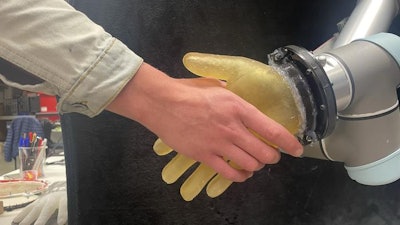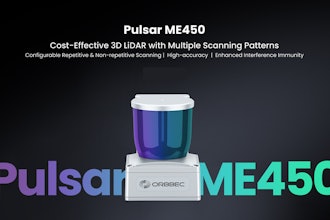
Scientists have developed a low-cost, durable, highly-sensitive robotic ‘skin’ that can be added to robotic hands like a glove, enabling robots to detect information about their surroundings in a way that’s similar to humans.
The researchers, from the University of Cambridge and University College London (UCL), developed the flexible, conductive skin, which is easy to fabricate and can be melted down and formed into a wide range of complex shapes. The technology senses and processes a range of physical inputs, allowing robots to interact with the physical world in a more meaningful way.
Unlike other solutions for robotic touch, which typically work via sensors embedded in small areas and require different sensors to detect different types of touch, the entirety of the electronic skin developed by the Cambridge and UCL researchers is a sensor, bringing it closer to our own sensor system: our skin.
Although the robotic skin is not as sensitive as human skin, it can detect signals from over 860,000 tiny pathways in the material, enabling it to recognize different types of touch and pressure – like the tap of a finger, a hot or cold surface, damage caused by cutting or stabbing, or multiple points being touched at once – in a single material.
The researchers used a combination of physical tests and machine learning techniques to help the robotic skin ‘learn’ which of these pathways matter most, so it can sense different types of contact more efficiently.
In addition to potential future applications for humanoid robots or human prosthetics where a sense of touch is vital, the researchers say the robotic skin could be useful in industries as varied as the automotive sector or disaster relief. The results are reported in the journal Science Robotics.
Electronic skins work by converting physical information – like pressure or temperature – into electronic signals. In most cases, different types of sensors are needed for different types of touch – one type of sensor to detect pressure, another for temperature, and so on – which are then embedded into soft, flexible materials. However, the signals from these different sensors can interfere with each other, and the materials are easily damaged.
Dr David Hardman from Cambridge’s Department of Engineering, said, “Having different sensors for different types of touch leads to materials that are complex to make. We wanted to develop a solution that can detect multiple types of touch at once, but in a single material.”
Their solution uses one type of sensor that reacts differently to different types of touch, known as multi-modal sensing. While it’s challenging to separate out the cause of each signal, multi-modal sensing materials are easier to make and more robust.
The researchers melted down a soft, stretchy and electrically conductive gelatin-based hydrogel, and cast it into the shape of a human hand. They tested a range of different electrode configurations to determine which gave them the most useful information about different types of touch. From just 32 electrodes placed at the wrist, they were able to collect over 1.7 million pieces of information over the whole hand, thanks to the tiny pathways in the conductive material.
The skin was then tested on different types of touch: the researchers blasted it with a heat gun, pressed it with their fingers and a robotic arm, gently touched it with their fingers, and even cut it open with a scalpel. The team then used the data gathered during these tests to train a machine learning model so the hand would recognize what the different types of touch meant.
In future, the researchers are hoping to improve the durability of the electronic skin, and to carry out further tests on real-world robotic tasks.






















